Blockchain Technology Implementation for Medical Record Security
VerifiedAdded on 2022/12/20
|5
|1085
|23
Report
AI Summary
This report analyzes the application of blockchain technology in securing medical records within the healthcare industry. The introduction highlights the importance of protecting sensitive patient data and introduces blockchain as a solution. The discussion section delves into how blockchain provides a secure and transparent method for managing medical records, emphasizing its encrypted nature and peer-to-peer network structure. It addresses the limitations of conventional centralized systems and highlights the benefits of blockchain in providing unique patient record versions across various healthcare providers. The report references several companies like Medibloc, Dentacoin, and Medicalchain that are developing blockchain-based solutions to give patients control over their medical records and prevent unauthorized access. The conclusion summarizes the potential of blockchain technology across various sectors, specifically focusing on its role in enhancing data security in healthcare. The references include several academic papers and articles supporting the discussed concepts and findings.
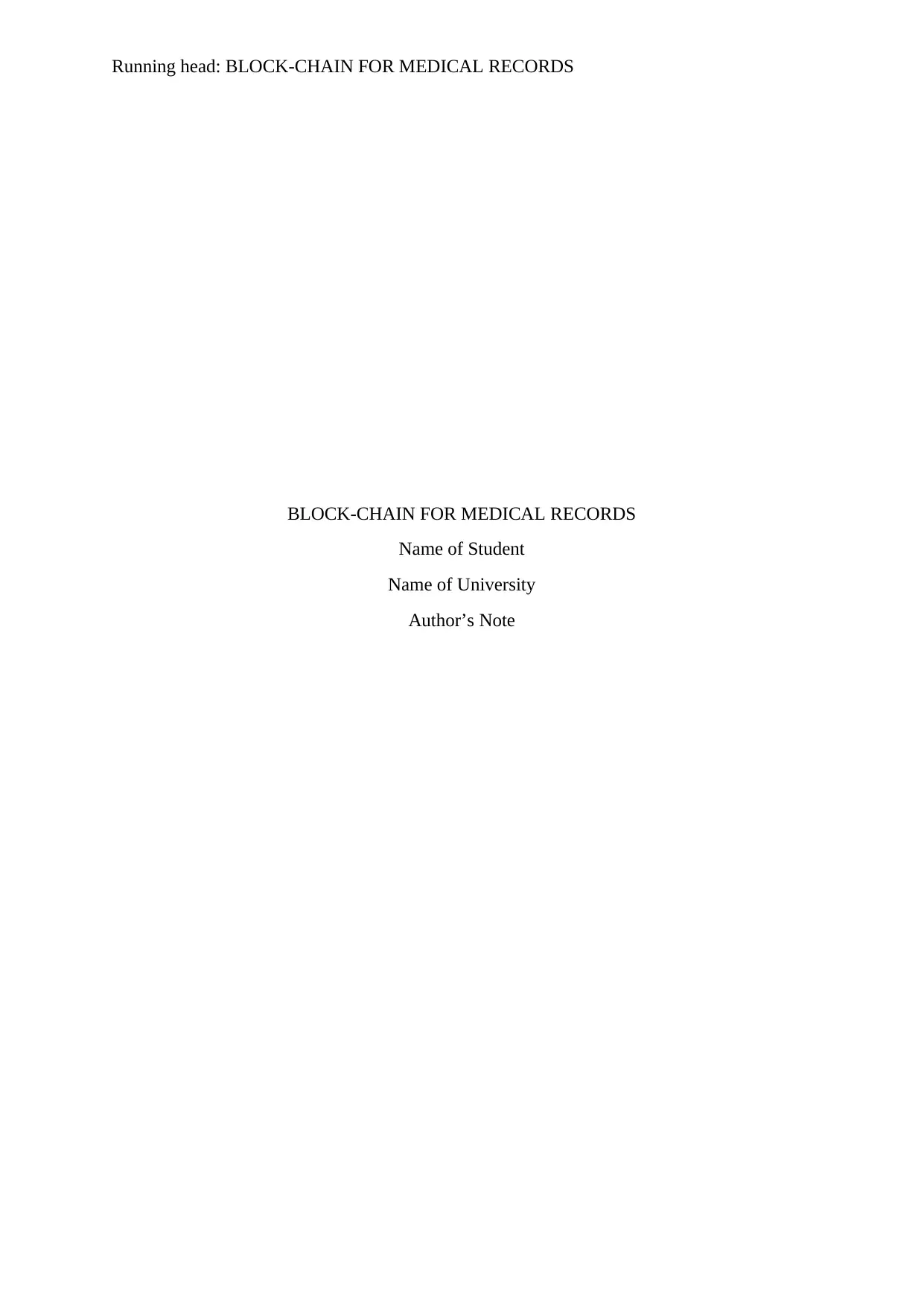
Running head: BLOCK-CHAIN FOR MEDICAL RECORDS
BLOCK-CHAIN FOR MEDICAL RECORDS
Name of Student
Name of University
Author’s Note
BLOCK-CHAIN FOR MEDICAL RECORDS
Name of Student
Name of University
Author’s Note
Paraphrase This Document
Need a fresh take? Get an instant paraphrase of this document with our AI Paraphraser
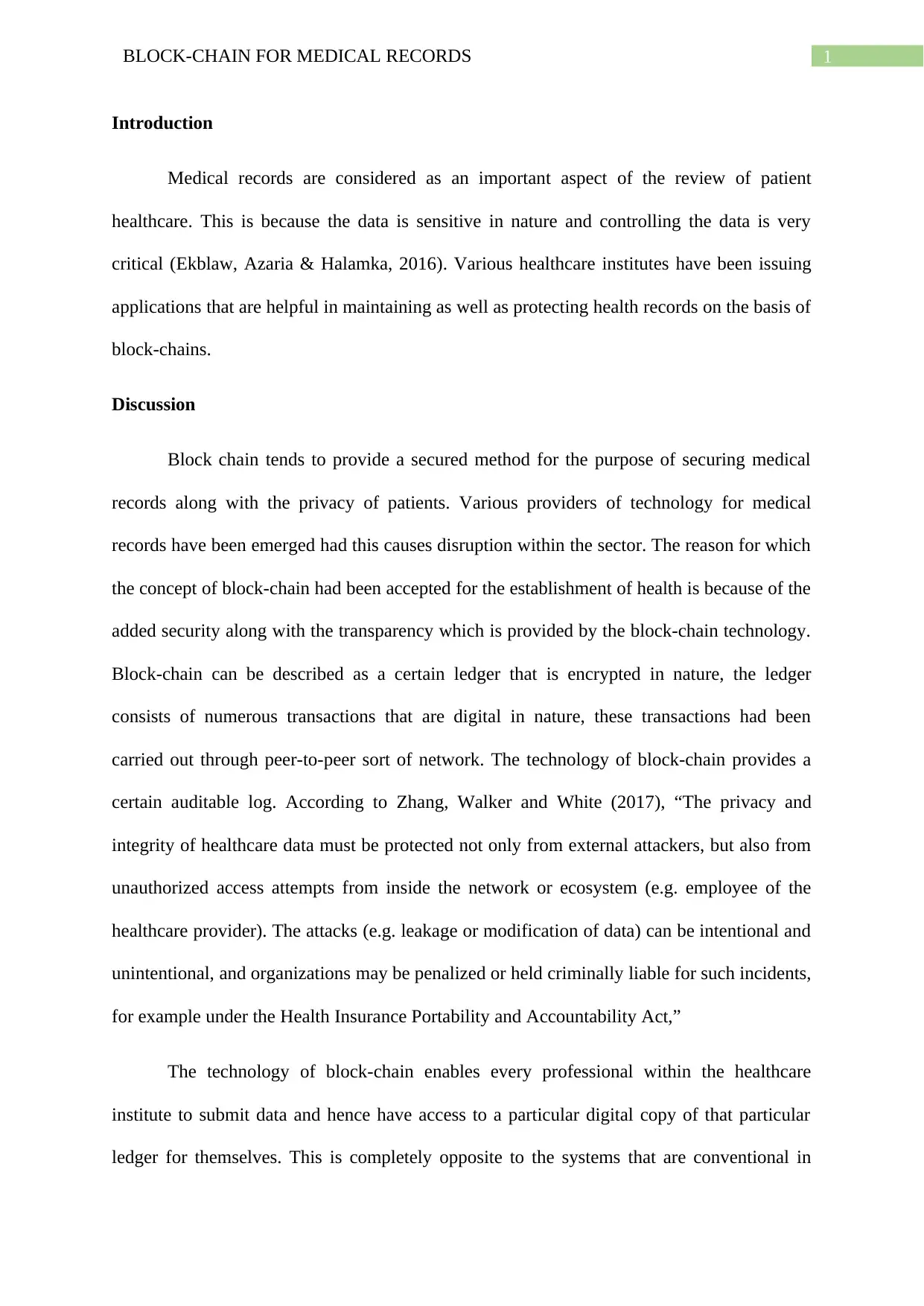
1BLOCK-CHAIN FOR MEDICAL RECORDS
Introduction
Medical records are considered as an important aspect of the review of patient
healthcare. This is because the data is sensitive in nature and controlling the data is very
critical (Ekblaw, Azaria & Halamka, 2016). Various healthcare institutes have been issuing
applications that are helpful in maintaining as well as protecting health records on the basis of
block-chains.
Discussion
Block chain tends to provide a secured method for the purpose of securing medical
records along with the privacy of patients. Various providers of technology for medical
records have been emerged had this causes disruption within the sector. The reason for which
the concept of block-chain had been accepted for the establishment of health is because of the
added security along with the transparency which is provided by the block-chain technology.
Block-chain can be described as a certain ledger that is encrypted in nature, the ledger
consists of numerous transactions that are digital in nature, these transactions had been
carried out through peer-to-peer sort of network. The technology of block-chain provides a
certain auditable log. According to Zhang, Walker and White (2017), “The privacy and
integrity of healthcare data must be protected not only from external attackers, but also from
unauthorized access attempts from inside the network or ecosystem (e.g. employee of the
healthcare provider). The attacks (e.g. leakage or modification of data) can be intentional and
unintentional, and organizations may be penalized or held criminally liable for such incidents,
for example under the Health Insurance Portability and Accountability Act,”
The technology of block-chain enables every professional within the healthcare
institute to submit data and hence have access to a particular digital copy of that particular
ledger for themselves. This is completely opposite to the systems that are conventional in
Introduction
Medical records are considered as an important aspect of the review of patient
healthcare. This is because the data is sensitive in nature and controlling the data is very
critical (Ekblaw, Azaria & Halamka, 2016). Various healthcare institutes have been issuing
applications that are helpful in maintaining as well as protecting health records on the basis of
block-chains.
Discussion
Block chain tends to provide a secured method for the purpose of securing medical
records along with the privacy of patients. Various providers of technology for medical
records have been emerged had this causes disruption within the sector. The reason for which
the concept of block-chain had been accepted for the establishment of health is because of the
added security along with the transparency which is provided by the block-chain technology.
Block-chain can be described as a certain ledger that is encrypted in nature, the ledger
consists of numerous transactions that are digital in nature, these transactions had been
carried out through peer-to-peer sort of network. The technology of block-chain provides a
certain auditable log. According to Zhang, Walker and White (2017), “The privacy and
integrity of healthcare data must be protected not only from external attackers, but also from
unauthorized access attempts from inside the network or ecosystem (e.g. employee of the
healthcare provider). The attacks (e.g. leakage or modification of data) can be intentional and
unintentional, and organizations may be penalized or held criminally liable for such incidents,
for example under the Health Insurance Portability and Accountability Act,”
The technology of block-chain enables every professional within the healthcare
institute to submit data and hence have access to a particular digital copy of that particular
ledger for themselves. This is completely opposite to the systems that are conventional in
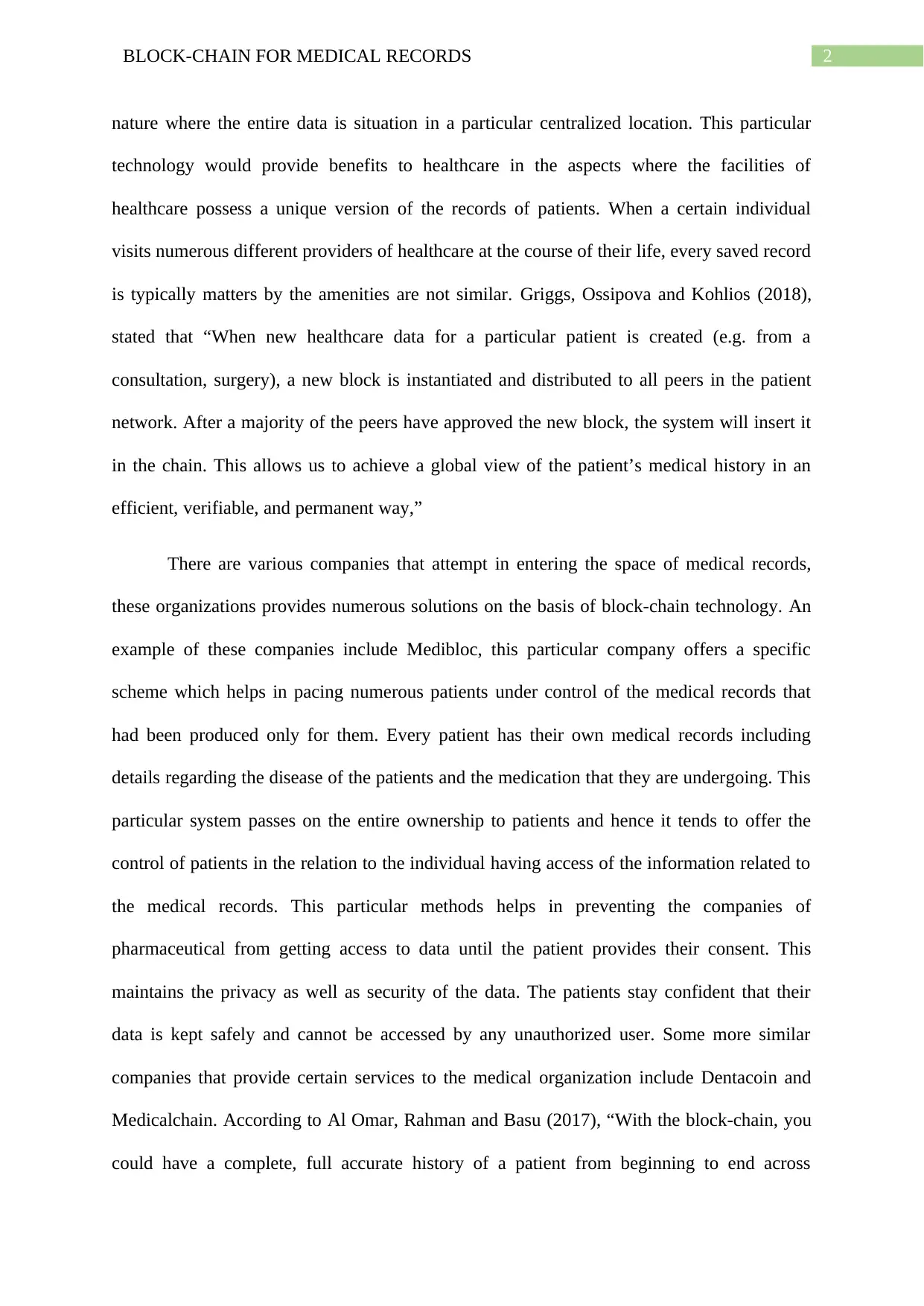
2BLOCK-CHAIN FOR MEDICAL RECORDS
nature where the entire data is situation in a particular centralized location. This particular
technology would provide benefits to healthcare in the aspects where the facilities of
healthcare possess a unique version of the records of patients. When a certain individual
visits numerous different providers of healthcare at the course of their life, every saved record
is typically matters by the amenities are not similar. Griggs, Ossipova and Kohlios (2018),
stated that “When new healthcare data for a particular patient is created (e.g. from a
consultation, surgery), a new block is instantiated and distributed to all peers in the patient
network. After a majority of the peers have approved the new block, the system will insert it
in the chain. This allows us to achieve a global view of the patient’s medical history in an
efficient, verifiable, and permanent way,”
There are various companies that attempt in entering the space of medical records,
these organizations provides numerous solutions on the basis of block-chain technology. An
example of these companies include Medibloc, this particular company offers a specific
scheme which helps in pacing numerous patients under control of the medical records that
had been produced only for them. Every patient has their own medical records including
details regarding the disease of the patients and the medication that they are undergoing. This
particular system passes on the entire ownership to patients and hence it tends to offer the
control of patients in the relation to the individual having access of the information related to
the medical records. This particular methods helps in preventing the companies of
pharmaceutical from getting access to data until the patient provides their consent. This
maintains the privacy as well as security of the data. The patients stay confident that their
data is kept safely and cannot be accessed by any unauthorized user. Some more similar
companies that provide certain services to the medical organization include Dentacoin and
Medicalchain. According to Al Omar, Rahman and Basu (2017), “With the block-chain, you
could have a complete, full accurate history of a patient from beginning to end across
nature where the entire data is situation in a particular centralized location. This particular
technology would provide benefits to healthcare in the aspects where the facilities of
healthcare possess a unique version of the records of patients. When a certain individual
visits numerous different providers of healthcare at the course of their life, every saved record
is typically matters by the amenities are not similar. Griggs, Ossipova and Kohlios (2018),
stated that “When new healthcare data for a particular patient is created (e.g. from a
consultation, surgery), a new block is instantiated and distributed to all peers in the patient
network. After a majority of the peers have approved the new block, the system will insert it
in the chain. This allows us to achieve a global view of the patient’s medical history in an
efficient, verifiable, and permanent way,”
There are various companies that attempt in entering the space of medical records,
these organizations provides numerous solutions on the basis of block-chain technology. An
example of these companies include Medibloc, this particular company offers a specific
scheme which helps in pacing numerous patients under control of the medical records that
had been produced only for them. Every patient has their own medical records including
details regarding the disease of the patients and the medication that they are undergoing. This
particular system passes on the entire ownership to patients and hence it tends to offer the
control of patients in the relation to the individual having access of the information related to
the medical records. This particular methods helps in preventing the companies of
pharmaceutical from getting access to data until the patient provides their consent. This
maintains the privacy as well as security of the data. The patients stay confident that their
data is kept safely and cannot be accessed by any unauthorized user. Some more similar
companies that provide certain services to the medical organization include Dentacoin and
Medicalchain. According to Al Omar, Rahman and Basu (2017), “With the block-chain, you
could have a complete, full accurate history of a patient from beginning to end across
⊘ This is a preview!⊘
Do you want full access?
Subscribe today to unlock all pages.

Trusted by 1+ million students worldwide
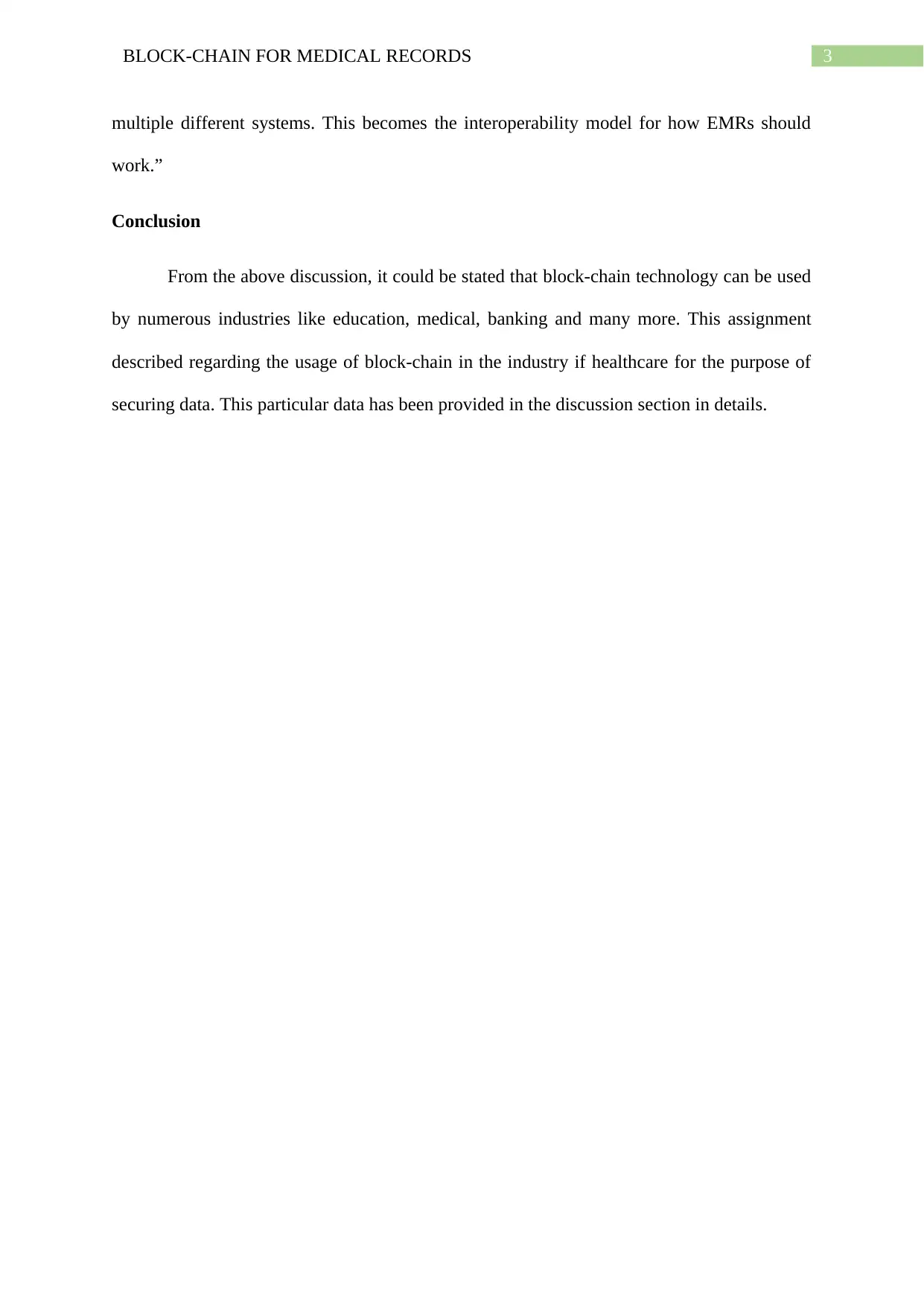
3BLOCK-CHAIN FOR MEDICAL RECORDS
multiple different systems. This becomes the interoperability model for how EMRs should
work.”
Conclusion
From the above discussion, it could be stated that block-chain technology can be used
by numerous industries like education, medical, banking and many more. This assignment
described regarding the usage of block-chain in the industry if healthcare for the purpose of
securing data. This particular data has been provided in the discussion section in details.
multiple different systems. This becomes the interoperability model for how EMRs should
work.”
Conclusion
From the above discussion, it could be stated that block-chain technology can be used
by numerous industries like education, medical, banking and many more. This assignment
described regarding the usage of block-chain in the industry if healthcare for the purpose of
securing data. This particular data has been provided in the discussion section in details.
Paraphrase This Document
Need a fresh take? Get an instant paraphrase of this document with our AI Paraphraser
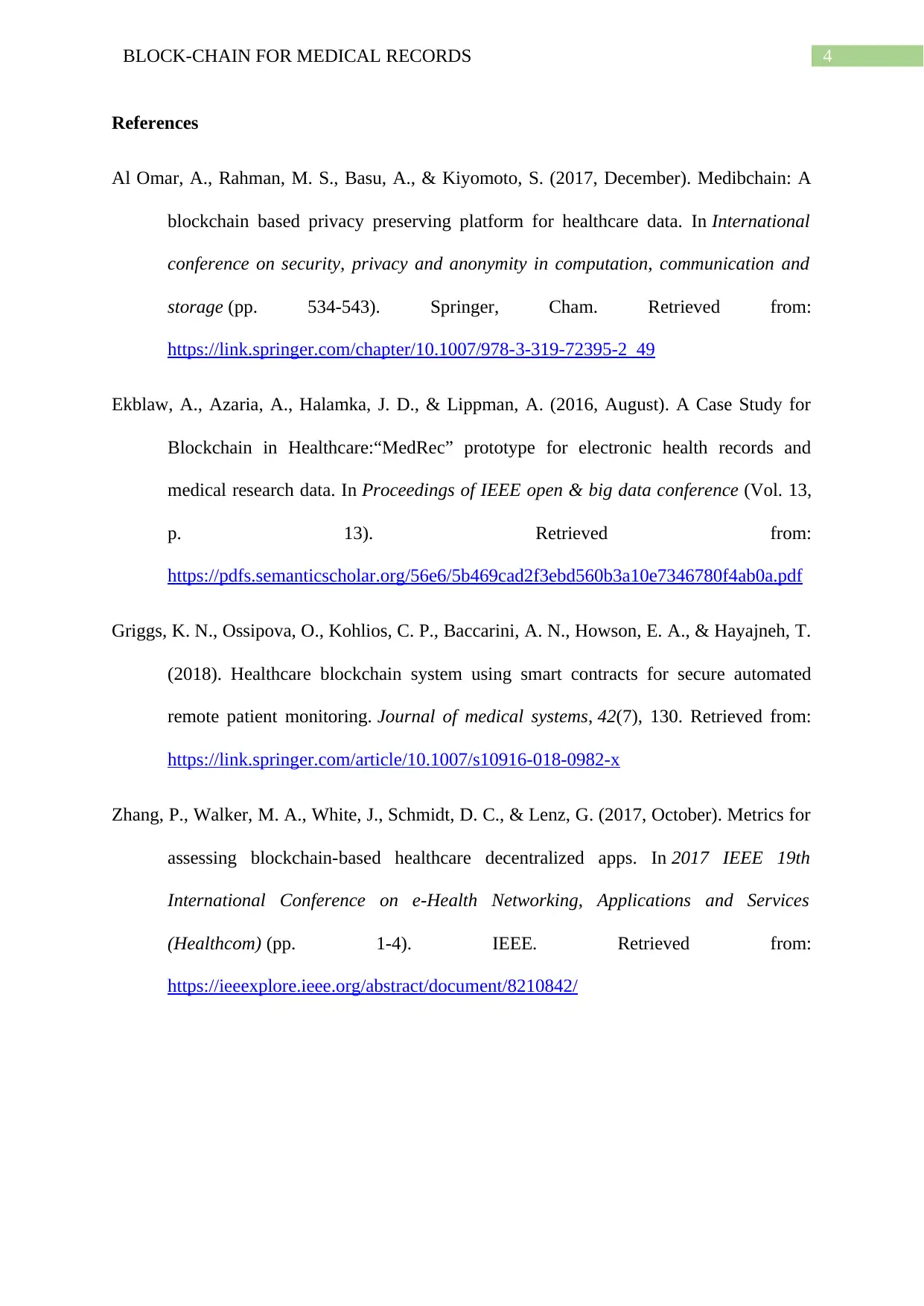
4BLOCK-CHAIN FOR MEDICAL RECORDS
References
Al Omar, A., Rahman, M. S., Basu, A., & Kiyomoto, S. (2017, December). Medibchain: A
blockchain based privacy preserving platform for healthcare data. In International
conference on security, privacy and anonymity in computation, communication and
storage (pp. 534-543). Springer, Cham. Retrieved from:
https://link.springer.com/chapter/10.1007/978-3-319-72395-2_49
Ekblaw, A., Azaria, A., Halamka, J. D., & Lippman, A. (2016, August). A Case Study for
Blockchain in Healthcare:“MedRec” prototype for electronic health records and
medical research data. In Proceedings of IEEE open & big data conference (Vol. 13,
p. 13). Retrieved from:
https://pdfs.semanticscholar.org/56e6/5b469cad2f3ebd560b3a10e7346780f4ab0a.pdf
Griggs, K. N., Ossipova, O., Kohlios, C. P., Baccarini, A. N., Howson, E. A., & Hayajneh, T.
(2018). Healthcare blockchain system using smart contracts for secure automated
remote patient monitoring. Journal of medical systems, 42(7), 130. Retrieved from:
https://link.springer.com/article/10.1007/s10916-018-0982-x
Zhang, P., Walker, M. A., White, J., Schmidt, D. C., & Lenz, G. (2017, October). Metrics for
assessing blockchain-based healthcare decentralized apps. In 2017 IEEE 19th
International Conference on e-Health Networking, Applications and Services
(Healthcom) (pp. 1-4). IEEE. Retrieved from:
https://ieeexplore.ieee.org/abstract/document/8210842/
References
Al Omar, A., Rahman, M. S., Basu, A., & Kiyomoto, S. (2017, December). Medibchain: A
blockchain based privacy preserving platform for healthcare data. In International
conference on security, privacy and anonymity in computation, communication and
storage (pp. 534-543). Springer, Cham. Retrieved from:
https://link.springer.com/chapter/10.1007/978-3-319-72395-2_49
Ekblaw, A., Azaria, A., Halamka, J. D., & Lippman, A. (2016, August). A Case Study for
Blockchain in Healthcare:“MedRec” prototype for electronic health records and
medical research data. In Proceedings of IEEE open & big data conference (Vol. 13,
p. 13). Retrieved from:
https://pdfs.semanticscholar.org/56e6/5b469cad2f3ebd560b3a10e7346780f4ab0a.pdf
Griggs, K. N., Ossipova, O., Kohlios, C. P., Baccarini, A. N., Howson, E. A., & Hayajneh, T.
(2018). Healthcare blockchain system using smart contracts for secure automated
remote patient monitoring. Journal of medical systems, 42(7), 130. Retrieved from:
https://link.springer.com/article/10.1007/s10916-018-0982-x
Zhang, P., Walker, M. A., White, J., Schmidt, D. C., & Lenz, G. (2017, October). Metrics for
assessing blockchain-based healthcare decentralized apps. In 2017 IEEE 19th
International Conference on e-Health Networking, Applications and Services
(Healthcom) (pp. 1-4). IEEE. Retrieved from:
https://ieeexplore.ieee.org/abstract/document/8210842/
1 out of 5
Related Documents
Your All-in-One AI-Powered Toolkit for Academic Success.
+13062052269
info@desklib.com
Available 24*7 on WhatsApp / Email
![[object Object]](/_next/static/media/star-bottom.7253800d.svg)
Unlock your academic potential
Copyright © 2020–2025 A2Z Services. All Rights Reserved. Developed and managed by ZUCOL.





